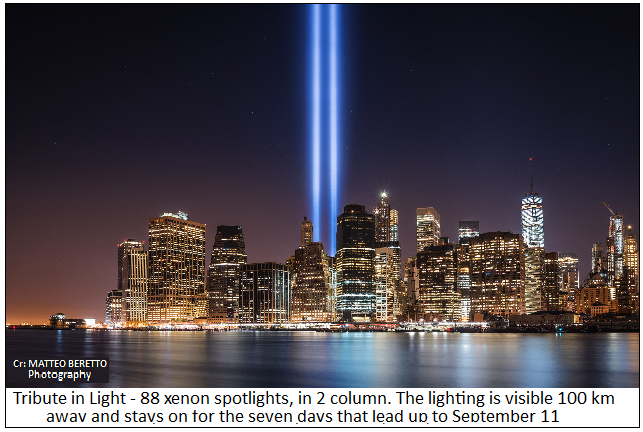Darkness is an essential feature of the night, says S.Ananthanarayanan.
There is ample evidence that numbers of bird species, and bird populations, in India and the world over, are rapidly reducing. In addition to the pressures that arise from climate change, there are the directly-human-caused pressures of disappearing habitats, pollution, the use of pesticides, and predation. And now the growing awareness that the use of lighting during the night is a major killer of several bird species.

An article by Joshua Sokol, a journalist in North Carolina, in Scientific American describes the dramatic effect that the annual, September 11th, Tribute in Light, an art installation to by New York City to mark the events of 2001, have on bird populations. “… as twin towers of light bloom skyward, they attract thousands of migrating birds, sucking in warblers, seabirds, and thrushes—along with predators such as peregrine falcons eager to take advantage of the confusion …… within 20 minutes, 16,000 birds cram themselves into a half kilometre radius,” and the once-a- year event brings together over a million birds, the article says.

When concerned observers on the ground find that too many birds are up there, the organizers turn down the lighting, the article says. And now, there is a radar-based system, the same that weather-folk use to estimate raindrops, to count birds on September 11, as well as to estimate the movement of migratory birds across the continent at different times of the year. And the September 11 study illustrates what impact the lights from cities in the flight path of migratory birds could have, the article says. “The circling birds burn through time and precious body fat, are easy prey, and worst of all, can brain themselves on the windows of nearby buildings,’ the article says
It is just as well that these studies are on, the article says, as slumping bird numbers have become disturbing. Over North America alone, in 2019, the article says, the number had fallen by over 3 billion, since 1970. Closer home, a portal called the Weather Channel reports that 80% of the 867 species of birds in India are in rapid decline, with 101 species in risk of extinction. These findings are the result of over 10 million observations by 15,500 birdwatchers across the country.
Falling numbers and diversity, of birds all over the world, has serious implications for food security. A first service that bird populations render is that of pest control. It has been estimated that birds eat 400-500 million tonnes of insects in a year. And birds are important players in the network of predators that keep rodent population under control. But for birds, the cost and the danger of chemicals used in pest control to maintain agriculture would exceed all other costs.
Even outside agriculture, birds maintain the balance of plant and herbivore, predator and prey, which allows marshes and grasslands to flourish, and these are the natural agents that store carbon, keep the climate stable, oxygenate the air and transform pollutants into nutrients. If it were not for birds, many of these ecosystems may not exist.
And again, although we think of butterflies and bees as the most important of pollinators, there are several niche plant varieties that are pollinated by birds. Flowers that do not have scent, and 5% of plants that we use as food or medicine, are pollinated by birds. And then, birds have the role of seed dispersal. When birds move from place to place, they carry with them the seeds they have eaten and deposit them in their droppings. Birds rejuvenate ecosystems that have been destroyed, carry plants even across the sea, and can transform landmasses. Of the 10 million hectares of forest in New Zealand, 70% grew out of seeds dispersed by birds.
“Some birds are considered keystone species as their presence in (or disappearance from) an ecosystem affects other species indirectly,” says Endangered Species International, which works for conservation, world-wide. “For example, woodpeckers create cavities that are then used by many other species. After the extinction of the dodo, it was discovered that a tree whose fruits had been a primary food item of the dodo was unable to reproduce without its seeds passing through the dodos’ digestive tracts, which process scarified the seed coat and enabled germination.”
The other role that birds perform is the work of cleaning-up. Vultures are known to reach a dead animal within an hour, and then to do a thorough job of disposing of the remains. A task that may take days if left to wild dogs or rats, which would lead to festering and spread of disease. The portal, BirdLife International estimates that the decline of the vulture in India has pushed up the population of wild dogs by 5.5 million, with spread of rabies, and 47,300 human deaths.
With so many roles in maintaining the ecology, birds have also adapted their own dependence by following local conditions through large, migratory flights. Thus, billions of birds in the colder north fly south for the winters, and then fly home again. And though migration has its costs and mortality, the pattern fits into the breeding seasons and numbers are maintained.
Except that brightly lit structures and cities, at night, along the birds’ flight path are seen to affect the birds’ navigation and create confusion. There is waste of energy, collisions and loss of organization -and a field day for predators. The glow of light from even a distant city, at night, can rival the illumination by the Milky Way and upset the birds’ sense of direction. And the mysterious attraction that birds have for bright lights propels the birds right into brightly lit window panes!
Nor is this a recent phenomenon. Back in 1880, the SCIAM article says, there were reports of night-time lights snaring birds – and a study of the effect of lighthouses (which burned oil lamps) revealed an instance of “more than a million birds” and “bushels of crumpled bodies”.
The experience with the Tribute in Light, in New York, brings out dramatically the scale of the damage that lighting at night wrecks on bird populations. Now, the article in Scientific American says, satellite imaging to create maps of regions of higher light intensity during the night and using radar to track the birds and their numbers, are used routinely. And in the US, the process identifies the cities whose lighting levels are most likely to affect migratory birds. There is then a program called BirdCast, the article says, which clubs weather radar data at a continent-scale and uses machine learning to “forecast the exact nights when hundreds of millions of migratory birds will torrent over U.S. cities.”
The information enables conservation-conscious groups to lobby with the administration of cities in the flight path to impose lighting regulation, like dimming, or shading of lights. And the efforts have been effective, the article says, with New York city having passed an ordinance that requires buildings to turn down their lights during migration season. And campaigning is on in dozens of other cities.
A movement that needs to take root the world over, to preserve a vital agency that keeps the ecology in order – to avoid a tragedy that may silently negate the gain of other efforts to keep the planet sustainable.
------------------------------------------------------------------------------------------ Do respond to : response@simplescience.in-------------------------------------------